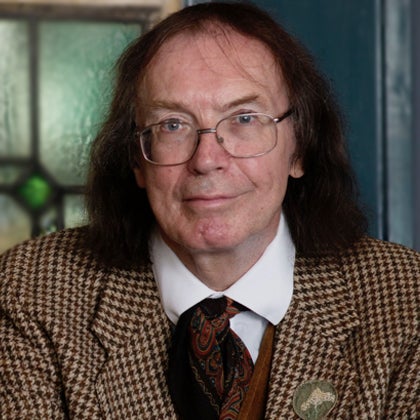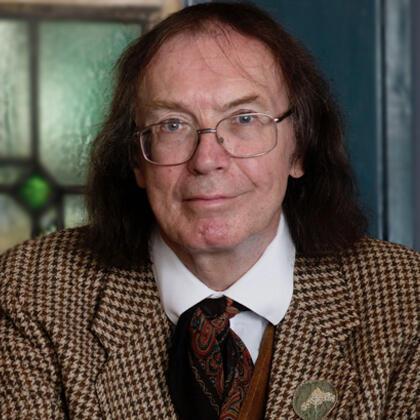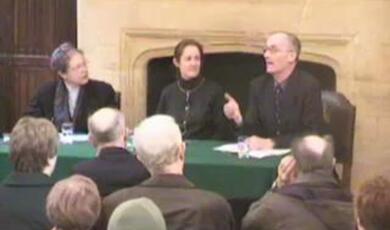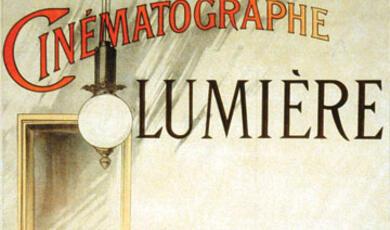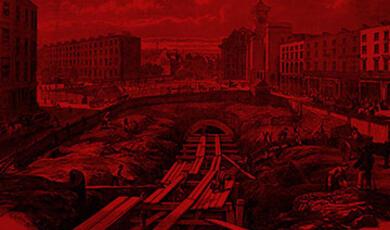How Pagan Was Medieval Britain?
Share
- Details
- Text
- Audio
- Downloads
- Extra Reading
Did paganism survive all through the Middle Ages, as scholars once thought, remaining the religion of the common people, while the elite had embraced Christianity? Or did it die out earlier?
This lecture will consider a broad range of evidence, including figures in seasonal folk rites, carvings in churches, the records of trials for witchcraft and a continuing veneration of natural places such as wells. It will also compare ancient paganism and medieval Christianity as successive religious systems.
Download Text
How Pagan Was Medieval Britain?
Professor Ronald Hutton
7th June 2023
The Historiographical Background
The Traditional Picture
For most of the twentieth century, the question posed in the title of this lecture would have been answered with the view that ancient paganism, in some form, had survived in Britain long after its official conversion to Chistianity. There was some difference over the exact form that it took, some scholars suggesting that the aristocracy had been mainly Christian but commoners clandestinely pagan, while others believed that the two faiths had long persisted amicably side by side, from top to bottom of society.
Geoffrey Coulton, a great historian of the medieval English Church, asserted in the 1920s that English peasants of the period had been ‘cheerful semi-pagans’, and had dutifully attended Christian services in the day but went home to venerate older deities in the evening. During the late nineteenth century a belief caught on among British scholars that the people persecuted as witches in the notorious witch trials of the early modern period had been practitioners of a surviving pagan fertility religion. This was given its fullest expression in the early twentieth century by Margaret Murray, whose books turned the idea into something of an orthodoxy by the 1960s. It was repeated by such giants of the historical profession as the medievalist Sir Stephen Runciman and the experts in the early modern period Sir George Clark and Christopher Hill.
Support to the idea of pagan survival was given by the medieval carvings in British churches. In 1939 a folklorist, Lady Raglan, drew attention to one form of them in particular, of human heads with foliage gushing from nose and/or mouth. She linked these to two other pieces of evidence. One was a figure found in Victorian May Day processions, of a man covered in dense vegetation, supported on a frame of wood. This was generally known as the ‘Jack-in-the-Green’. The other was a common pub sign, labelled ‘The Green Man’, and by modern times usually showing a forester, or Robin Hood. Lady Raglan suggested that all three represented the same original pagan god, a deity of returning greenery and fertility to whom she gave the name of the Green Man, appropriated from the sign. His place in many churches suggested that the Christian clergy had been forced to tolerate his presence in order to propitiate the ordinary people who still venerated him.
Margaret Murray, who did so much to popularise the idea of the early modern witch trials as a persecution of pagans, made another important contribution to a belief in persisting paganism. During the 1930s she drew attention to a different form of enigmatic medieval church carving, showing a woman facing the observer and displaying her genitals. Scholars had generally given these the Irish nickname of ‘sheela-na-gig’. She interpreted these as a representation of a pagan fertility goddess, placed in churches like that of the Green Man to satisfy those who continued to worship her.
These ideas not only continued to be accepted outside the academic system during the late twentieth century, made an impact on its wider culture. Margaret Murray’s portrait of a pagan witch religion made a major contribution to the development of such a religion in the modern Western world, called Wicca. The pioneering scholar of British Iron Age paganism, Anne Ross, accepted the interpretation of the sheela-na-gig as a goddess, linking the image to a deity whom she called ‘the divine hag of the pagan Celts’. In 1975 she went further, teaming up with a photographer to produce a popular book called Grotesques and Gargoyles. In this she interpreted sheela-na-gigs, Geen Men and a few other mofits carved in medieval churches as representations of pagan deities. She accused academic scholars of virtually ‘a conspiracy of silence’ to conceal this evidence for the reality of a persistent pagan religion through the Middle Ages and beyond.
Radical movements appropriated these images for their own uses. Feminist artists adopted the sheela-na-gig as a powerful symbol of female sexuality, empowerment and self-confidence. The Green Movement naturally took up the Green Man as a motif, especially after the London poet William Anderson hailed it as an archetypal representation of the power of the endangered natural world. There is no doubt that these medieval images have become dynamic and emotive components of modern culture.
The Reality
A great deal of research was needed to pool the data needed to evaluate the truth of all these claims, as the data was so disparate and scattered. However, from the late 1970s this work began, powered by the expansion and greater dynamism of higher education, and by a new mood of reexamination of Victorian and Edwardian beliefs.
The idea of the witch trials as a persecution of pagans, most associated with Margaret Murray, collapsed first. Sustained and widespread research into the trial records, across the whole of Europe and its colonies, proved that the individuals prosecuted for witchcraft had not been pagans, even though ancient ideas had played a part in creating some of the belief systems that had produced the trials.
After that, the component parts of Lady Raglan’s construct of the Green Man were dismantled. The medieval foliate heads were studied by Kathleen Basford in 1978 and Mercia MacDermott in 2003. They were revealed to have been a motif originally developed in India, which travelled through the medieval Arab empire to Christian Europe. There it became a decoration for monks’ manuscripts, from which it spread to churches. The Jack-in-the-Green was studied by Roy Judge in 1979, and proved to have appeared in London at the end of the eighteenth century. It was initially a feature of chimney sweeps’ processions, enacted to collect money in May as the onset of summer extinguished domestic fires and removed much of the sweeps’ income. The Green Man sign was studied by Brandon Centerwall in 1997, and shown to derive from the medieval motif of the Wild Man of the forest. This figure, of a human dressed in leaves, passed into Tudor and Stuart pageants, then became a brand symbol for distillers, aided by the connection between vines and wine, and so ended up as a name for pubs. None of the three things had anything to do with each other or with a pagan god.
Further research revealed the true context of the sheela-na-gig. In 1977 Jørgen Andersen realised that it comes from France, and was found there and in Spain as much as in the British Isles. It was part of a new style of church decoration in the eleventh and twelfth centuries, Romanesque, and spread along major pilgrimage routes. In 1984 Anthony Weir and James Jerman confirmed this and suggested that it was a warning against sins of the flesh, intended to revolt and repel onlookers instead of inviting veneration. Their case is now generally accepted, but there may be an exception to it in Ireland, where the motif is often found on secular buildings and where the eye cannot reach, and was linked to a folk tradition that a woman could avert evil by exposing her genitals to it. In Ireland, therefore, the sheela-na-gig may indeed link in to ancient pagan belief. That is not however the original point of it, nor the usual meaning that seems to have been placed upon it.
The Historical Evidence
Now all those red herrings have been removed, what actual evidence is there for the survival of paganism in medieval Britain? There are two bodies of directly relevant material, from opposite ends of the Middle Ages, and both consist of legal records. The first comprises Anglo-Saxon law codes and church council decrees, that forbid pagan practices among the English.These certainly exist in the seventh and early eighth centuries, but they end in the course of the eighth century. They then reappear in the tenth, to deal with the newly arrived pagan Viking settlers who had just been converted to Christianity. This second series however also comes to an end after 1030.
At the other end of the Middle Ages, in the fifteenth century, we have the records of church courts, that dealt with religious and moral offences among local populations. Certainly many people did offend the established Church’s view of proper religious belief and practice at that time. There were plenty in some areas with heretical Christian ideas, who were known at the time as ‘Lollards’, and a few sceptics and scoffers. There is, however, nothing resembling paganism, with the single possible example of a Hertfordshire man who allegedly declared that there were no gods but the sun and moon. He was however not a member of a cult or an advocate of the worship of these heavenly bodies, but an individual cynic suggesting that all religious belief was pointless. Is it possible that pagans could have continued to practise their religion in secret by this time without ever being detected? It seems very unlikely if the Lollards could not. Something that the church court records bring home very strongly is the sheer nosiness of ordinary people at the time, and their strong sense of the need to conform to communal norms. To take a classic example from my own city of Bristol, in 1539 a young widow called Margery Northoll was prosecuted for breach of contract after she had agreed to marry one man and then ditched him for another. There were witnesses able to report overhearing what the first man and Margery had said to each other at every stage of their courtship, in their most private conversations.
Between these two major bodies of evidence are three isolated cases assembled by Margaret Murray as evidence for continuing paganism. The first was a chronicle entry for 1282, that the priest at Inverkeithing, Scotland, had forced girls to dance around a human image, carrying a carved phallus on a pole. He was not, however, the leader of a pagan community but a lone maniac, who also forced his parishioners to strip and whip each other and was then murdered by them. The second case was from Kent in 1313, where a man called Stephen Le Pope worshipped images of gods he had made and set up in his garden. He was clearly another solitary lunatic, because he murdered his maid on the same night. Finally, in 1351 the monks of Frithelstock Priory, Devon, were accused by their local bishop, of Exeter, of running a fortune-telling racket for money and erecting an image of ‘proud and disobedient Eve or unchaste Diana’ in their chapel. The monks, however protested that it was an icon of the Virgin Mary, and the bishop concerned was a most unusual one, a frenetic evangelical reformer.
It may therefore be concluded that there is no real evidence for genuine paganism in Britain after 1030.
The Religious Context
The obvious question now to be posed is why this was, and the answer offered here is that medieval British Christianity made paganism unnecessary by reproducing its features in a parallel form, united to a very different theology. Those features were
Polytheism
Paganism had many deities. The equivalent in Christianity was provided by saints, who were likewise of both sexes and with many different individual areas of potency. There were hundreds from which to choose. Some had a very localised following. Cornwall alone, famously, had scores. Walstan of Bawburgh was venerated by twenty parishes in Norfolk, and Sidwell in Exeter and East Devon. Just as with pagan deities, the relationship of people with saints was very ad-hoc: they went to them for help when they had specific problems. Such approaches could be much more important to ordinary commoners than mainstream religion, and this remains a feature of traditional Roman Catholic societies. In the French department of Logère in the 1960s it was found that 5% of the working class inhabitants had attended a service in their parish church during the previous year, but 49% of men and 78% of women had visited a saint’s shrine.
Just like pagan deities, saints were patrons of specific trades, age groups, cures for illnesses, genders, nations, regions, farming processes and animals. Some were clearly overworked. St Clement was patron of blacksmiths, anchor-makers, iron-workers and carpenters. St Blaise cared for woolcombers, wax-chandlers, wild animals and (appropriately for somebody with a feast day in early February) sore throats. Like pagan deities, also, natural places such as wells and trees were sacred to saints, so that those seeking their help did not need to enter a church if they did not wish it.
On the whole, pagan temples in Britain were not changed directly into Christian churches, nor pagan deities into saints. Pope Gregory the Great, who sent the first Christian missionaries to the Anglo-Saxons, wrote a famous letter in which he ordered that temples indeed be transformed into Christian churches. This however does not seem to have happened, perhaps as the flimsy little wooden shrines of the pagan English were not suitable as communal Christian places of worship. Only thirty-three out of one and a half thousand medieval parish churches in Britain have been shown to have had any apparent pre-Christian activity on their site. No British saints seem to have been former pagan deities, in contrast to the situation in Ireland and abroad. Even sacred waters have little overlap. Major pagan sacred springs such as Coventina’s well at Carrawburgh and the hot waters of the goddess Sulis Minerva at Bath were not apparently Christianised. Conversely, only one medieval Christian holy well in Essex, had evidence of cult activity in pagan times as well. Christianity seems therefore not to have adapted pagan buildings and figures for its use, so much as to have provided a similar, but parallel, service. This is reflected in church buildings, so that by 1500 the average parish church contained anything from three to thirty shrines dedicated to saints who were not the parish patrons (and sometimes over thirty). Many of these were served by guilds, local societies dedicated to the saints concerned, which maintained their own priests and were open to all but the very poor.
Festivals
Just as in pagan times, so in the Christian Middle Ages, seasonal festivals were the main religious events. There was no law compelling people to attend church weekly before the 1550s. Occasional local snapshots show that about half of parishioners did not go there regularly. The churches were, however, crowded out for the big spectacular annual feasts. They sang in the dawn together on Christmas Day, and had candles blessed at Candlemas in February, to represent new light and welcome the spring. They brought new foliage to be blessed on Palm Sunday and attended the drama of the resurrection of Christ on Easter Day, represented by a consecrated wafer of bread taken from a miniature sepulchre. In May clergy led Rogationtide processions to bless the growing crops and on Whit Sunday a white dove was released in the church to symbolise the Holy Spirit.
Otherwise the priests were there to celebrate services themselves regularly on behalf of all parishioners, including those absent, just as pagan priests had maintained temples. Parishioners provided the images, hangings, carvings, gilding, incense and music. Scriptural meanings were imposed on ancient calendar feasts, but the feasts themselves were kept going. Traditional secular revelry converged with religion as the Middle Ages went on, so that May games, village summer feasts, and collections by ploughboys in January all came to be means of raising funds for the parish church. The Devil was cheated, in that merrymaking which had at first been condemned by churchmen as leading to sin became harnessed to pay for worship.
The Feminine
The medieval Christian Church had ample space for the feminine, human and divine. About half of all saints were women, led by Mary, the Queen of Heaven herself, whose images took on trappings from the pagan goddesses Juno, Venus and Diana. Women functioned as parish churchwardens and guild members (with equal rights). Nunneries gave them private religious spaces, and some made great reputations as hermits and authors, such as Julian of Norwich. All this served to erect a thick screen before a fundamentally patriarchal religion.
Sacrifice
In medieval Christianity as in ancient paganism, the central ritual act was sacrifice, but not of animals, libations or incense as before. Instead the self-sacifice of the divine saviour of the religion was commemorated by offering up his body and blood symbolically in the mass. This was the essential rite that needed to be celebrated regularly. Preaching was popular but not essential, and provided from the thirteenth century, often at wayside crosses or in market places, by professionals, the friars. The priests who served parishes were not required to preach, or even be literate, and were generally local, and ordinary, people.
Conclusion
Looking to the future, it is clear that both the Protestant Reformation and the Catholic Counter-Reformation, which began together in the sixteenth century were intended to end this system of medieval religion. Both sought more uniformity, better central control, better education and a piety more closely based on the Bible. In the British case, Protestantism drove out the saints, mass, decorations, women, festive customs and secular merrymaking. It was a self-conscious removal of pagan parallels.
What it brought in, however, was not a new age of faith but a shattering of Christian unity, followed later by religious pluralism and secularistion. The result was by the late twentieth century a modern version of the medieval situation, with priests or ministers keeping churches going while only the devout attended among the lay population. In the 1990s, it was found that 10% of the British went to church or chapel regularly, but 62% believed in a personal God, 65% still professed to be Christian, and 90% celebrated Christmas.
Among the new forms of religious pluralism to appear in the twentieth century was a revived paganism, to complicate and round off the British religious picture. That however is a story for another course of these lectures.
© Professor Ronald Hutton, 2023
Further Reading
Hutton, Ronald. Pagan Britain. 2013, pp. 274-396.
Yorke, Barbara. The Conversion of Britain. 2006.
Lambert, Malcolm. Christians and Pagans. 2010.
Hylson-Smith, Kenneth, Christianity in Britain from Roman Times to the Reformation. 1999
Further Reading
Hutton, Ronald. Pagan Britain. 2013, pp. 274-396.
Yorke, Barbara. The Conversion of Britain. 2006.
Lambert, Malcolm. Christians and Pagans. 2010.
Hylson-Smith, Kenneth, Christianity in Britain from Roman Times to the Reformation. 1999
Part of:
This event was on Wed, 07 Jun 2023
Support Gresham
Gresham College has offered an outstanding education to the public free of charge for over 400 years. Today, Gresham College plays an important role in fostering a love of learning and a greater understanding of ourselves and the world around us. Your donation will help to widen our reach and to broaden our audience, allowing more people to benefit from a high-quality education from some of the brightest minds.


 Login
Login
